Urban Villages
 The Fraseropolis Urban Villages project considers sites in British Columbia’s Lower Mainland where people can live, shop and enjoy life within a walkable area.
The Fraseropolis Urban Villages project considers sites in British Columbia’s Lower Mainland where people can live, shop and enjoy life within a walkable area.
Our UV Index was developed for fun by half a dozen people. It’s built around Canadian West Coast standards. Most of our villages are architecturally humdrum, and housing is expensive compared to most of North America. In an increasingly difficult housing market, we consider whether residents or prospective residents can find housing choice, convenient transit, essential retail services and good-quality public amenities including recreation. We’re trying to get at the question of what makes a neighbourhood livable. We’re also keen to show diehard Vancouverites that there’s life beyond Commercial Drive and 41st Ave.
The Urban Villages index speaks to the availability of services for residents. Visitors look for something else — charm and cultural interest, or natural beauty. Any village in the following set is worth a half-day trip:
Vancouver’s West End is close to Stanley Park, the Vancouver Art Gallery, and much else. Uptown New West is adjacent to one of the finest heritage residential areas in B.C. Ambleside has a fine seafront on the North Shore, facing Stanley Park. Deep Cove offers a range of pathways and trails from easy to challenging, with excellent ocean views and famous doughnuts. Edgemont, on the North Shore slopes, is worth a Sunday afternoon coffee and stroll. Fort Langley has a national historic park and two other museums, plus galleries, gift shops, cafes and a riverfront walking trail. The White Rock seafront lacks village services, but offers many bars and cafes and a wonderful promenade. Crescent Beach, not too far away, provides a lower-key combination of neighbourhood and seafront walk. Steveston, in the city of Richmond, provides a full-service village with a touristic waterfront and a national historic site.
Entries in the Urban Villages index:
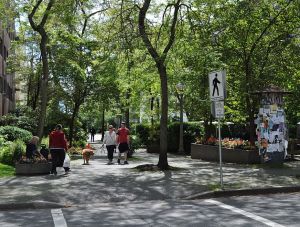 West End Vancouver (City of Vancouver): 25 or more walkable storefront blocks, depending on what you include in the village. A heavily-treed, densely-populated, sophisticated neighbourhood bordering on downtown Vancouver, English Bay and Stanley Park. Like every successful urban village complex, it’s at risk from overdevelopment and touristic overexposure. Apartment purchase prices are among the highest in Canada. 84/100.
West End Vancouver (City of Vancouver): 25 or more walkable storefront blocks, depending on what you include in the village. A heavily-treed, densely-populated, sophisticated neighbourhood bordering on downtown Vancouver, English Bay and Stanley Park. Like every successful urban village complex, it’s at risk from overdevelopment and touristic overexposure. Apartment purchase prices are among the highest in Canada. 84/100.
West Broadway (City of Vancouver), aka the west side of Kitsilano: About 21 storefront blocks. There is choice in housing and services here, if you have money. The residential streets are cute and well-manicured; the high street is dog-eared in spots, but this is changing. Densification is limited mostly to the addition of laneway housing and the subdivision of existing houses. 83.5/100.
Uptown New West (City of New Westminster). About 17 walkable storefront blocks. The commercial buildings are unmemorable, but in good condition. Transit, recreation, shops, cafes, good stock of rental and seniors housing, fine streets of heritage  residences close by. 80/100.
residences close by. 80/100.
Ambleside (District of West Vancouver). About 15 walkable storefront blocks. A scenic waterfront position and high-quality retail and public services. 80/100.
Commercial Drive (City of Vancouver). About 40 walkable storefront blocks. Home to social activists and artists. Transit, community centre, cafes, offbeat retail, with co-op housing and rental housing options. 78.5/100.
Downtown New West (City of New Westminster). About 18 walkable storefront blocks. Excellent access to transit and an increasingly interesting waterfront. This area has seen steady residential tower development over more than 20 years, and new shopping centres provide most of the services residents need. There are still historic bits; the old high street is visually attractive, but struggling to find a purpose as a retail area. First visited in 2013, scored at 76; scored higher in 2018. 78.5/100.
Central Lonsdale (City of North Vancouver). About 24 walkable storefront blocks between 8th Ave. and the Upper Levels Highway. Plenty of housing choice, shops and public amenities. Controversy over development, but a pro-development Council was re-elected and the village’s Fraseropolis score has been increased as Central Lonsdale evolves. 77.5/100.
Joyce/Collingwood (City of Vancouver). About 20 walkable storefront blocks split between Kingsway above and Joyce Street below. This is a little-known area (for Vancouver) with excellent transit connections and a broad choice of housing. 77/100.
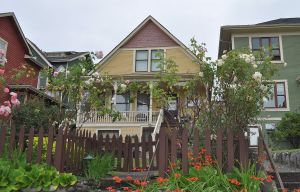 Lower Lonsdale (City of North Vancouver). About 20 walkable storefront plus the Lonsdale Quay. Developing rapidly along its waterfront, Lower Lonsdale offers an urban vibe and easy transit to downtown Vancouver. Some key services are located in Central Lonsdale, a nearby village to the north. 77/100.
Lower Lonsdale (City of North Vancouver). About 20 walkable storefront plus the Lonsdale Quay. Developing rapidly along its waterfront, Lower Lonsdale offers an urban vibe and easy transit to downtown Vancouver. Some key services are located in Central Lonsdale, a nearby village to the north. 77/100.
Downtown Langley (City of Langley). About 18 walkable storefront blocks. There’s a wasteland along the northern perimeter, and too much traffic, but Downtown Langley is notable for choice and affordability in housing as well as an attractive (if undersized) core. The City is working to expand the core’s “realm of influence.” 76/100.
Downtown Port Coquitlam (City of Port Coquitlam). About 12 walkable storefront blocks. A strong community feeling; newish medium-density housing in and adjacent to the core; retail services, public amenities and recreation. 75.5/100.
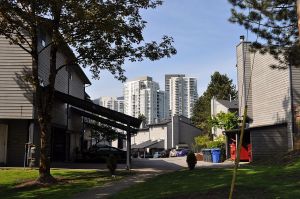 Newport Village/Suter Brook (City of Port Moody). About 13 walkable storefront blocks. Manufactured to suit the market for urban villages, Newport has inspired the construction of a clone (Suter Brook) close by. Transit and municipal services, and a range of housing and shops in and around the high-end Newport core. Marred by wide, busy roads and a lack of community focus. 75.5/100.
Newport Village/Suter Brook (City of Port Moody). About 13 walkable storefront blocks. Manufactured to suit the market for urban villages, Newport has inspired the construction of a clone (Suter Brook) close by. Transit and municipal services, and a range of housing and shops in and around the high-end Newport core. Marred by wide, busy roads and a lack of community focus. 75.5/100.
White Rock Uptown (City of White Rock). About 15 walkable storefront blocks. A high concentration of services for people over the age of 65, a relatively dry climate, and close proximity to a fine waterfront promenade. The village looked a little threadbare when we visited, with some deteriorating properties awaiting development. 74/100.
Marpole (City of Vancouver). About 14 walkable storefront blocks on the part of  Granville Street just north of the Fraser River. The planning area designated as Marpole stretches to Cambie, but this is outside the walkable village. Marpole sits alongside some of the plushest parts of Vancouver, but a wide swath of rental housing adds diversity. The Granville commercial zone is a little skinny on services, and very noisy. The City government would like to densify; some residents say no thanks. 73.5/100.
Granville Street just north of the Fraser River. The planning area designated as Marpole stretches to Cambie, but this is outside the walkable village. Marpole sits alongside some of the plushest parts of Vancouver, but a wide swath of rental housing adds diversity. The Granville commercial zone is a little skinny on services, and very noisy. The City government would like to densify; some residents say no thanks. 73.5/100.
Steveston (City of Richmond). About 14 walkable storefront blocks. The Steveston core has seen considerable development since 2005 and now combines the cafes and gift shops of a regional tourist destination with a fair selection of resident services, housing choice and transit. 72.5/100.
The Heights (City of Burnaby). About 21 walkable storefront blocks along Hastings Street in Burnaby, with an additional few blocks on the Vancouver side of Boundary Road. Built along a now-vanished streetcar line, it still has good transit and a range of services. Burnaby’s plan to build residential density along Hastings is proceeding, but there is little increase in housing choice in the surrounding residential area. First reviewed in 2012, revisited in 2017 with a drop of half a scoring point. 72.0/100.
 Vancouver Chinatown (City of Vancouver). About 8 walkable storefront blocks. A great location next to downtown Vancouver and close to False Creek, but some will find the Chinatown core intolerable, with some of Canada’s worst street scenes only a block or two away. The traditional commercial life is dying away, and some structures are crumbling; pretty residential streets nearby, interesting new commercial ventures, lots of potential. 72.0/100.
Vancouver Chinatown (City of Vancouver). About 8 walkable storefront blocks. A great location next to downtown Vancouver and close to False Creek, but some will find the Chinatown core intolerable, with some of Canada’s worst street scenes only a block or two away. The traditional commercial life is dying away, and some structures are crumbling; pretty residential streets nearby, interesting new commercial ventures, lots of potential. 72.0/100.
Kerrisdale (City of Vancouver). A pretty neighbourhood and fine commercial streets perched on the Arbutus Greenway. Some of the most expensive real estate in Canada. Hard to tell how the area is likely to evolve in the apparent absence of an area plan. 71.5/100
Coquitlam City Centre (City of Coquitlam) About 11 walkable storefront blocks plus the Coquitlam Centre megamall and other parking-lot-oriented plazas. The plan is to make this area a commercial and entertainment hub for a wide area of the region. There has been progress in making it liveable and walkable. 71/100.
Edmonds (City of Burnaby). The forced marriage of a modest medium-density neighbourhood with transit-oriented towers. Perhaps 14 walkable storefront blocks, but they are intermittent and the definition of the village area is debatable. A good range of services, difficult to make out the theme. 70.5/100.
Oak Bay Village (City of Oak Bay). This is outside Fraseropolis, located across the Salish Sea in Greater Victoria. It’s included here only for comparison. A sedate, charming, high-end village with a fair range of services. About 11 walkable storefront blocks, interrupted. 70.5/100.
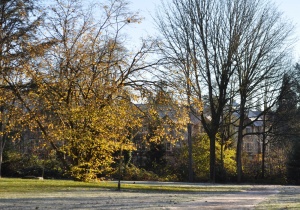 Lougheed Town Centre (Split between the City of Burnaby and the City of Coquitlam). This may not appear to be a village to the first-time visitor. An abundance of housing types and retail and commercial services, but dominated by busy highways and parking lots and underweight in community services. 68.5/100
Lougheed Town Centre (Split between the City of Burnaby and the City of Coquitlam). This may not appear to be a village to the first-time visitor. An abundance of housing types and retail and commercial services, but dominated by busy highways and parking lots and underweight in community services. 68.5/100
Wesbrook Village (University of British Columbia). An aggressive university-sponsored program to build densified housing on the campus perimeter includes a modest but attractive village core (about six storefront blocks). Adjacent to parks and the ocean. Definitely not a mixed-income community, sitting as it does alongside some of the priciest residential real-estate. 68.0/100.
The East Village (City of Vancouver). About 16 walkable storefront blocks, shading into industrial and automotive at the western end. What was a combination of lower-income and immigrant neighbourhoods is evolving rapidly with condo development on Hastings Street and million-dollar prices on detached homes. 67.5/100
Semiahmoo (City of Surrey). Adjacent to White Rock Uptown, this is the proposed site for a major town centre development. Very good housing choice, but services are modest in scope as of 2017 with about 9 walkable storefront blocks. Transit is frequent but the distance to Skytrain is long. 67/100
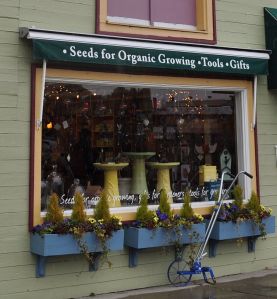 Ladner (Municipality of Delta). A prosperous and attractive village core with waterfront nearby and the convenience of three shopping centres within easy walking distance. A moderately good range of medium-density housing. The current municipal plan would restrict the village to roughly its current size in order to protect the surrounding sea of detached homes. 66/100.
Ladner (Municipality of Delta). A prosperous and attractive village core with waterfront nearby and the convenience of three shopping centres within easy walking distance. A moderately good range of medium-density housing. The current municipal plan would restrict the village to roughly its current size in order to protect the surrounding sea of detached homes. 66/100.
Newton Town Centre (City of Surrey). A variety of services and housing choices close to transit, on the east side of King George Highway. The residential and commercial parts are not well-integrated, and the commercial parts have close to zero charm for pedestrians. 66/100.
Lynn Valley Town Centre (District of North Vancouver). A mall-centric commercial area with very little street appeal, but with a decent range of services and a fine setting. This is a designated municipal town centre in North Vancouver, and changing fast. 65.5/100.
Pitt Meadows Town Centre (City of Pitt Meadows). About 8 walkable storefront blocks. Located in the northeast of the region, and off the mental map of many people. This quiet, slightly upscale neighbourhood offers a good quality of living if you are prepared to rely on the automobile. 65.5/100.
South Hill (or South Fraser Street) (City of Vancouver): About 17 walkable storefront blocks. It’s more livable than most parts of suburbia and offers a range of services on the high street, but it lacks focus and the housing choice is thin. 64/100.
 Fort Langley (Township of Langley). About 12 walkable storefront blocks. A good destination for a day out, with antique stores, cafes and a riverfront trail. Among communities in the outer suburbs, it’s a desirable residential location. A growing but still incomplete set of commercial services; few community services and scanty transit. 63.5/100
Fort Langley (Township of Langley). About 12 walkable storefront blocks. A good destination for a day out, with antique stores, cafes and a riverfront trail. Among communities in the outer suburbs, it’s a desirable residential location. A growing but still incomplete set of commercial services; few community services and scanty transit. 63.5/100
Maple Ridge Town Centre (District of Maple Ridge): About 20 walkable storefront blocks. Cosmetic upgrades and some service improvements since 2010; a good range of services, but too dispersed. Infill housing is required, along with an increased focus on the pedestrian environment. 63.5/100.
Esquimalt Village (City of Esquimalt). A small and modestly-served village in Greater Victoria, one of Canada’s most livable urban regions. Village expansion was proceeding in 2016. 63/100.
Sapperton (City of New Westminster). About 9 walkable storefront blocks. Excellent rapid transit service and a central location within the region. Otherwise this village is stretched thin from north to south, and pressed up against a railway line and industrial zone. As of late 2017, the City was considering a tower-centric development plan nearby that might or might not build a Sapperton community. 62.0/100.
Tsawwassen (Municipality of Delta). About 9 walkable storefront blocks. This is an attractive suburb in a superb location. The town centre offers a range of housing and locally-owned businesses, but it straddles a busy highway and lacks pedestrian appeal. 59/100.
 Austin Heights (City of Coquitlam). About 9 long walkable storefront blocks. A 2011 City plan aims to jazz up what local officials admit is a “tired” commercial core surrounded mostly by single-family housing. Even so, the village offers a useful range of services and is well-located in the region. 59/100.
Austin Heights (City of Coquitlam). About 9 long walkable storefront blocks. A 2011 City plan aims to jazz up what local officials admit is a “tired” commercial core surrounded mostly by single-family housing. Even so, the village offers a useful range of services and is well-located in the region. 59/100.
Downtown Abbotsford (City of Abbotsford): About 10 walkable storefront blocks. A one-time railway village. Big push for commercial revitalization, but the pedestrian links to surrounding residential nodes are not inviting. 58.5/100.
Edgemont (District of North Vancouver.) About 11 walkable storefront blocks. A nice place to visit, with the feel of a mountain resort. 58.5/100.
Mission City (District of Mission): About 9 long walkable storefront blocks. A compact village core with some appealing features; there is some housing choice a block or two from First Avenue, but little sense of momentum. 54.5/100.
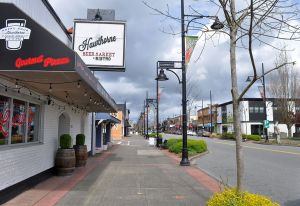 Cloverdale (City of Surrey). About 14 walkable storefront blocks. Built along a historic commuter railway line, now vanished, with good examples of vintage architecture. Cafes, professional offices and some shopping. Even with a growing population in this area of Surrey and a college campus nearby, there has been little recent development here (2016). 52.0/100.
Cloverdale (City of Surrey). About 14 walkable storefront blocks. Built along a historic commuter railway line, now vanished, with good examples of vintage architecture. Cafes, professional offices and some shopping. Even with a growing population in this area of Surrey and a college campus nearby, there has been little recent development here (2016). 52.0/100.
Brookswood (Township of Langley). Dates from the 1950s, with detached homes on large lots plus a couple of mobile home parks. Qualifies as an urban village because local government has made a controversial decision to densify. The shopping centre is within walking distance for many residents, with a supermarket, fast food, and an otherwise patchy set of services. Good access to nature and recreational trails. 52.0/100.
Aldergrove (Township of Langley). About 8 walkable storefront blocks. Like Cloverdale, and Downtown Abbotsford, a railway village dating from about 1900. Riven by almost constant highway traffic through the centre. Transit connections are rare. An ambitious village plan, adopted in 2010 by the municipal council, recognizes the considerable potential of this site. 46.5/100.
A comment from Ellen Heaney:
Good to see uptown New Westminster near the top of the list. I have worked in the area for 38 years, starting at a time when Woodward’s was the big uptown draw and a lot of older single-family housing had recently been replaced with 3-story apartment buildings – still a staple of the residential landscape in 2012.
The neighbourhood has seen its ups and downs, but it is still nice that there is an area where shopping and services (including every financial institution known to mankind), and, of course, a wonderful public library, is reachable on foot.